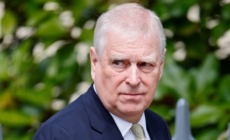-
U.S. extreme skier Jim Morrison skis down Mount Everest - 22 mins ago
-
Scam text hit voters smartphones. What to look out for ahead of Nov. 4 - 22 mins ago
-
CeeDee Lamb Makes Feelings Known on George Pickens’ Cowboys Future - 24 mins ago
-
Top 5 NFL Bets To Make Right Now | Week 9 - 41 mins ago
-
Coachella mayor indicted on charges of perjury, conflict of interest - about 1 hour ago
-
BetMGM Bonus Code NW150: Claim $150 Bonus For Ravens-Dolphins, NBA Games - about 1 hour ago
-
King Charles III removes Prince Andrew’s titles and honors formally - about 1 hour ago
-
Tony Vitello Takes Daunting Step From College to MLB Dugout as Giants Manager - about 1 hour ago
-
Recalled Pasta Sold at Walmart, Trader Joe’s Leading to More Reported Illnesses, Deaths - 2 hours ago
-
Wife to government employee earns $5K in side hustles during shutdown - 2 hours ago
Louvre Heist Latest: Seven Suspects Arrested, None of $102m Jewels Recovered
French authorities have arrested five additional suspects in connection with the audacious daylight theft of French crown jewels from the Louvre Museum’s Apollo Gallery—but the priceless treasures remain missing.
The arrests took place late Wednesday in coordinated police operations across Paris and nearby suburbs, including Seine-Saint-Denis, Paris Prosecutor Laure Beccuau told RTL radio. The suspects’ identities have not been released.
Beccuau said one of the detainees is believed to have been part of the four-person crew that carried out the October 19 robbery, a heist that stunned France and the world. Two other alleged members of the gang were arrested Sunday and formally charged Wednesday with criminal conspiracy and organized theft. Both have partially confessed, according to prosecutors.
Louvre Priceless Jewels Remain Missing
“Searches last night and overnight did not allow us to find the goods,” Beccuau said.
The thieves took less than eight minutes to make off with eight pieces of the French crown jewels, valued at roughly €88 million ($102 million). They forced open a window, sliced through display cases with power tools and sped away on scooters along the Seine River.
Beccuau issued a direct appeal to whoever possesses the jewels: “These jewels are now, of course, unsellable. Anyone who buys them would be guilty of concealment of stolen goods. There’s still time to give them back.”

Louvre Heist Suspects: What We Know
Authorities say one of the charged suspects, a 34-year-old Algerian national living in France since 2010, was apprehended at Charles de Gaulle Airport as he attempted to board a flight to Algeria without a return ticket. His DNA was found on one of the getaway scooters, investigators said. The second suspect, a 39-year-old man also from Aubervilliers, was already known to police for thefts; his DNA was discovered on the shattered display case and other items left behind.
Surveillance footage shows at least four people were involved. Investigators believe the group arrived in a truck equipped with a freight lift, which two men used to reach the museum’s window before fleeing on scooters to eastern Paris, where other vehicles were waiting.
Officials have found no evidence of insider involvement by Louvre staff.
How Did Daring Louvre Heist Unfold?
Around 9:30 a.m., a group of intruders broke into the Louvre in a daring daylight heist, forcing a window open and slicing through panes with a disc cutter before heading straight for the museum’s prized glass display cases, officials said.
Interior Minister Laurent Nunez reported that the thieves accessed the museum from the riverfront side, using a basket lift to reach the Apollon Gallery—a grand hall that houses the royal Crown Diamonds, including the famed Regent, the Sancy, and the Hortensia.

Once inside, the gang smashed two display cases and made off with several jewels before speeding away on motorbikes. No injuries were reported. Security alarms drew Louvre staff to the scene within moments, but the thieves had already vanished with their haul.
What was Stolen from the Lourve?
Eight objects were taken, according to officials: a sapphire diadem, necklace and single earring from a matching set linked to 19th-century French queens Marie-Amélie and Hortense; an emerald necklace and earrings from the matching set of Empress Marie-Louise, Napoleon Bonaparte’s second wife; a reliquary brooch; Empress Eugénie’s diadem; and her large corsage-bow brooch—a prized 19th-century imperial ensemble.
One object, the emerald-set imperial crown of Napoleon III’s wife, Empress Eugénie, containing more than 1,300 diamonds, was later found outside the museum on the street. It was broken.

When was the Louvre built?
The Louvre Palace was originally built in the late 12th century, around 1190, under King Philip II of France.
It began as a fortress designed to defend Paris against Viking invasions via the Seine River. Parts of those medieval fortifications can still be seen today in the museum’s lower levels.
Over the centuries, the Louvre was transformed and expanded—first into a royal palace during the 16th century under Francis I, then into the world-famous museum it is today after the French Revolution in 1793, when it officially opened to the public as the Muséum central des arts de la République.
The Louvre has long been shadowed by a history of audacious thefts and near-misses. The most famous came in 1911, when Leonardo da Vinci’s Mona Lisa vanished from its frame—stolen by Italian decorator Vincenzo Peruggia and missing for more than two years before resurfacing in Florence.

Decades later, in 1956, the masterpiece suffered another assault when a visitor hurled a stone at the painting, chipping pigment near her left elbow. The attack led to the museum’s decision to encase the Mona Lisa behind protective glass.
French President Emmanuel Macron said in January that the museum is undergoing a renovation with a new entrance near the River Seine planned to open by 2031.
Source link































